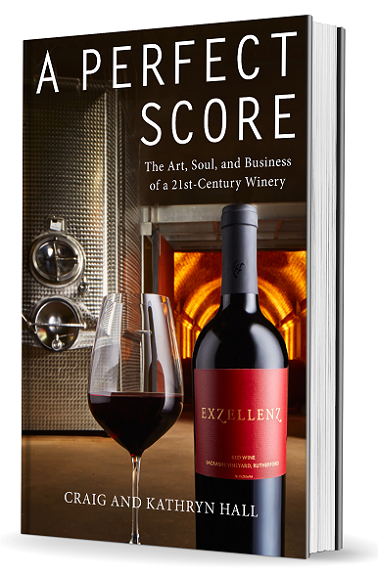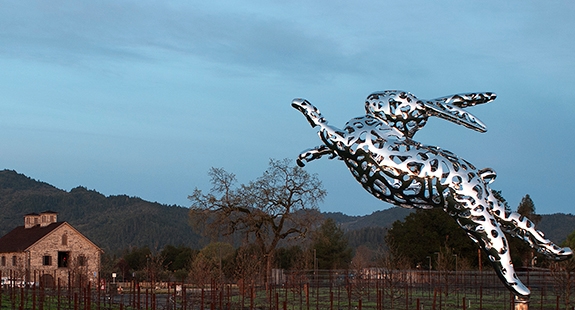The
Napa Valley Vintners Association teamed up with
The Daily Sip and the Sip’s editor-in-chief
Karen MacNeil for a virtual wine tasting event which featured a sextet of “Unexpected Napa Wines.” What, exactly, are unexpected Napa wines? @TheDailySip tweeted the answer during the event. “We looked for classic estates making unexpected wines,” they chirped. “The #Napa Valley is a hotbed of American innovation,” they continued. “Traditions thrive and evolve while winemakers explore the new.”
The six wines tasted ranged from a mildly unexpected unoaked Chardonnay to quite unexpected California Albarino, Chenin Blanc and Petit Verdot to Fumé Blanc and Cabernet Sauvignon - which I would say are far from unexpected in Napa Valley. I was invited to join this little party and was provided samples of the wines for that purpose. This series covers the wines separately.
The
Mondavi name is anything but unexpected when the talk turns to the Napa Valley. Sauvignon Blanc and Cabernet Sauvignon also fail to shock, but it is what the Mondavi winery does with these grapes that provides the twist.
The late
Robert Mondavi helped put California wine on the map, so it is no surprise that the entryway to his winery looks like a cross between a mission and a cathedral. Those who enter worship at the altar of Sauvignons, both red and white.
Robert Mondavi Winery 2013 Fumé Blanc
The 2013 Mondavi
Napa Valley Fumé Blanc is 90% Sauvignon Blanc and 10% Sémillon. Mondavi created the term "fumé blanc" in 1966 to draw a line between his dry style of Sauvignon Blanc and the sweeter white wines of the day. It sells for $20.
@TheDailySip informed that, "The fruit for this Fumé Blanc comes primarily from #StagsLeap & the celebrated #ToKalon #vineyard in Oakville." There is nothing like a great vineyard or two.
@KMacWine tweeted that the wine "has a non-aggressive greenness I call chaparral." A great note, and it's nice have a name for that quality.
@Path2Wine chirped, "When you hear "Fume Blanc" you think @RobertMondavi This is a timeless, classic Sauvignon Blanc."
@timlemke cut to the chase: "Too often friends dismiss Mondavi wines as mass produced, but I'll drink this Fumé Blanc anyday." Support came from
@winecompass: "Even a mass produced wine made from 20% To Kalon grapes by default has to be very drinkable, right?" It sure worked this time.
@laughrodite4U remembered "my first taste of Robert Mondavi #Fume Blanc in 1985. Served with a pork roast." And I'll bet it was delish that way.
@TheGoodWineGuru was "really liking the softer notes of the Fume Blanc." As was I.
Mondavi's '13
Fumé Blanc may not be unexpected, but it sure is good. Pale yellow in the glass, its nose gives subtle fruit and a soft earthiness. The wine is very much in the old-world style of Sauvignon Blanc. There is almost no grassiness on the nose, with stone fruit and tropical notes coming forth. The palate is just as elegant, with a softness that is quite unexpected in this grape. Slightly smoky apricot and mango are in the forefront, while acidity takes a backseat. I would love this with a ham as much as I would with bacon and eggs. Yes, for breakfast, even at 14.5% abv.
Robert Mondavi Winery 2012 Cabernet Sauvignon
This Cabernet is made from 88% Cabernet Sauvignon grapes, 6% Cabernet Franc, 4% Merlot, and 1% each of Petit Verdot and Malbec. It hits 14.5% abv and Director of Winemaking
Genevieve Janssens says it reminds her of why Mondavi built the brand on Cabernet Sauvignon.
The Mondavi cab drew praise from
@WineOhTV: "Fantastic & affordable @ under $30 I'm a fan!"
@KMacWine reports that "There are some places where a grape just thrives. #Cabernet was destined to be made in the #Napa Valley." It would be hard to argue that point.
@TheGoodWineGuru "Really liked the dried herbs and dark fruit on the nose," while
@SandyWasserman liked "the cherry fruit and mild tannins."
@KMacWine tweeted, "This @RobertMondavi #cabernet offers a tremendous value. Each glass would only cost you the equivalent of a Starbucks latté." And it brings a bit more pleasure to the drinker.
@WineCompass cited the "blackberries prevalent throughout; herbaceous and textured, long soft finish," while
@GoodWineArtist picked up on "a lot of plum on this Cab, nice dark rich fruit flavors and good tannins but not too dry." Pointing out the obvious, @KMacWine typed that "#Steak and #cabernet are one of those thrilling pairings where the wine and food crave one another."
@Shona425 liked the "lush, rich blackberry chocolate. Long finish. #Napa cab always a classic." More notes from
@PrimlaniKitchen: "Classic Napa - Black Fruit, Cherries, Eucalyptus, Cloves - an Effortless Drinking wine." It has staying power, too, according to
@macdaddy_m: "After tasting 30 consecutive vintages of this wine I am never disappointed."
The '12 Mondavi Cab is colored dark and rich, and layered textures burst forth on the nose. Blackberry and cassis lead the way, with a beautiful savory note of black olive. The palate is tasty enough - a little thin for me - with the dark fruit making itself at home and leaving little purple footprints into the finish. Tannins are good, but not overly aggressive. The wine's aromas make a promise the flavors can't keep. It's not a great Cabernet, but at $20, I don't expect it to be. What it is, is a good $20 Cab.
Follow Randy Fuller on Twitter




